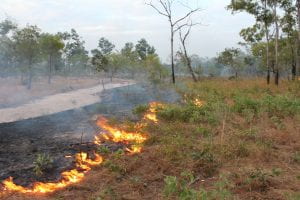Is Anthropogenic Pyrodiversity Invisible in Paleofire Records?
Around the globe, anthropogenic burning regimes often involve burning very small patches at relatively high frequencies. This creates a fine-grained mosaic of post-fire succession communities that benefits many species and often promotes biodiversity. This anthropogenic pyrodiversity is often difficult to identify in the historical ecology of environments that already experience frequent fires. Is this a weakness of paleofire methods? Is it an inherent problem in identifying fire regime differences that are relatively low-contrast?
In a recent paper with Grant Williamson and David Bowman in the journal Fire, I explore these issues with a simple cellular model of varying fire regimes and simulated fire-scar tree-ring records. Although anthropogenic pyrodiversity is not necessarily invisible in paleofire records, it is much easier to identify when paleofire and cultural information are integrated.
You can find the paper here or on my publications page.
Roos, Christopher I., Grant W. Williamson, and David M.J.S. Bowman (2019) Is Anthropogenic Pyrodiversity Invisible in Paleofire Records? Fire, 2, 42.

Comments are Disabled